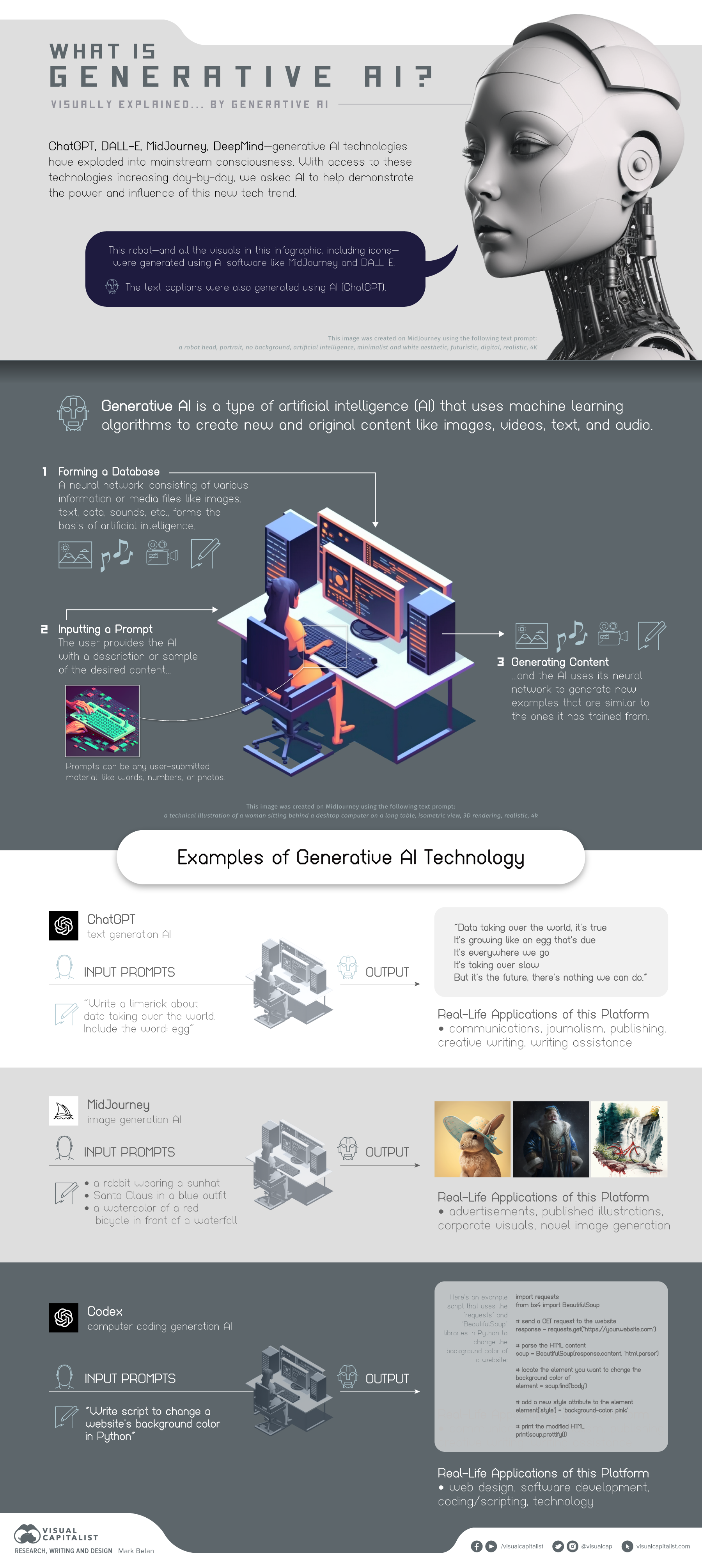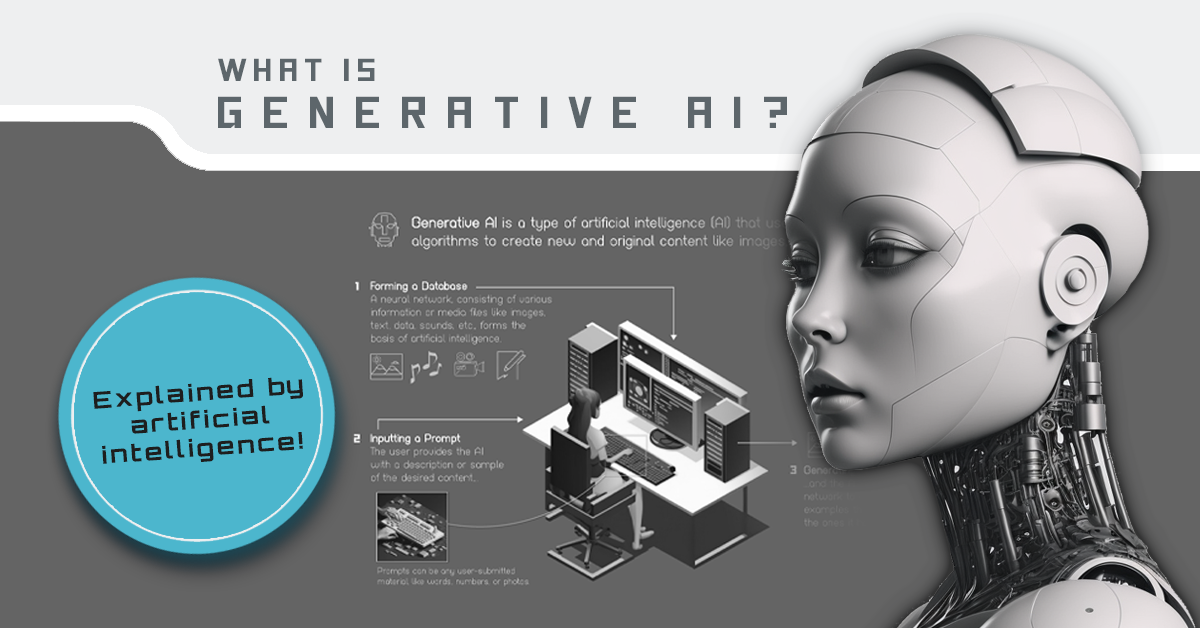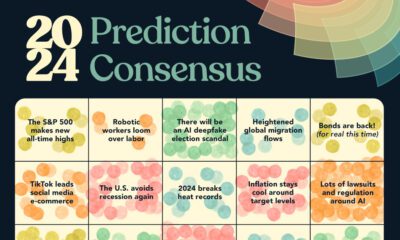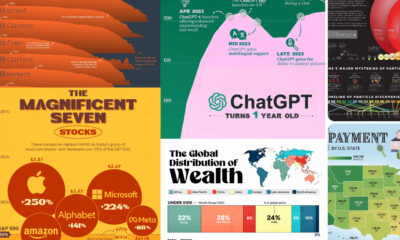Technology
Infographic: Generative AI Explained by AI

Generative AI Explained by AI
After years of research, it appears that artificial intelligence (AI) is reaching a sort of tipping point, capturing the imaginations of everyone from students saving time on their essay writing to leaders at the world’s largest tech companies. Excitement is building around the possibilities that AI tools unlock, but what exactly these tools are capable of and how they work is still not widely understood.
We could write about this in detail, but given how advanced tools like ChatGPT have become, it only seems right to see what generative AI has to say about itself.
Everything in the infographic above – from illustrations and icons to the text descriptions—was created using generative AI tools such as Midjourney. Everything that follows in this article was generated using ChatGPT based on specific prompts.
Without further ado, generative AI as explained by generative AI.
Generative AI: An Introduction
Generative AI refers to a category of artificial intelligence (AI) algorithms that generate new outputs based on the data they have been trained on. Unlike traditional AI systems that are designed to recognize patterns and make predictions, generative AI creates new content in the form of images, text, audio, and more.
Generative AI uses a type of deep learning called generative adversarial networks (GANs) to create new content. A GAN consists of two neural networks: a generator that creates new data and a discriminator that evaluates the data. The generator and discriminator work together, with the generator improving its outputs based on the feedback it receives from the discriminator until it generates content that is indistinguishable from real data.
Generative AI has a wide range of applications, including:
- Images: Generative AI can create new images based on existing ones, such as creating a new portrait based on a person’s face or a new landscape based on existing scenery
- Text: Generative AI can be used to write news articles, poetry, and even scripts. It can also be used to translate text from one language to another
- Audio: Generative AI can generate new music tracks, sound effects, and even voice acting
Disrupting Industries
People have concerns that generative AI and automation will lead to job displacement and unemployment, as machines become capable of performing tasks that were previously done by humans. They worry that the increasing use of AI will lead to a shrinking job market, particularly in industries such as manufacturing, customer service, and data entry.
Generative AI has the potential to disrupt several industries, including:
- Advertising: Generative AI can create new advertisements based on existing ones, making it easier for companies to reach new audiences
- Art and Design: Generative AI can help artists and designers create new works by generating new ideas and concepts
- Entertainment: Generative AI can create new video games, movies, and TV shows, making it easier for content creators to reach new audiences
Overall, while there are valid concerns about the impact of AI on the job market, there are also many potential benefits that could positively impact workers and the economy.
In the short term, generative AI tools can have positive impacts on the job market as well. For example, AI can automate repetitive and time-consuming tasks, and help humans make faster and more informed decisions by processing and analyzing large amounts of data. AI tools can free up time for humans to focus on more creative and value-adding work.
How This Article Was Created
This article was created using a language model AI trained by OpenAI. The AI was trained on a large dataset of text and was able to generate a new article based on the prompt given. In simple terms, the AI was fed information about what to write about and then generated the article based on that information.
In conclusion, generative AI is a powerful tool that has the potential to revolutionize several industries. With its ability to create new content based on existing data, generative AI has the potential to change the way we create and consume content in the future.
Technology
Ranked: Semiconductor Companies by Industry Revenue Share
Nvidia is coming for Intel’s crown. Samsung is losing ground. AI is transforming the space. We break down revenue for semiconductor companies.
Semiconductor Companies by Industry Revenue Share
This was originally posted on our Voronoi app. Download the app for free on Apple or Android and discover incredible data-driven charts from a variety of trusted sources.
Did you know that some computer chips are now retailing for the price of a new BMW?
As computers invade nearly every sphere of life, so too have the chips that power them, raising the revenues of the businesses dedicated to designing them.
But how did various chipmakers measure against each other last year?
We rank the biggest semiconductor companies by their percentage share of the industry’s revenues in 2023, using data from Omdia research.
Which Chip Company Made the Most Money in 2023?
Market leader and industry-defining veteran Intel still holds the crown for the most revenue in the sector, crossing $50 billion in 2023, or 10% of the broader industry’s topline.
All is not well at Intel, however, with the company’s stock price down over 20% year-to-date after it revealed billion-dollar losses in its foundry business.
| Rank | Company | 2023 Revenue | % of Industry Revenue |
|---|---|---|---|
| 1 | Intel | $51B | 9.4% |
| 2 | NVIDIA | $49B | 9.0% |
| 3 | Samsung Electronics | $44B | 8.1% |
| 4 | Qualcomm | $31B | 5.7% |
| 5 | Broadcom | $28B | 5.2% |
| 6 | SK Hynix | $24B | 4.4% |
| 7 | AMD | $22B | 4.1% |
| 8 | Apple | $19B | 3.4% |
| 9 | Infineon Tech | $17B | 3.2% |
| 10 | STMicroelectronics | $17B | 3.2% |
| 11 | Texas Instruments | $17B | 3.1% |
| 12 | Micron Technology | $16B | 2.9% |
| 13 | MediaTek | $14B | 2.6% |
| 14 | NXP | $13B | 2.4% |
| 15 | Analog Devices | $12B | 2.2% |
| 16 | Renesas Electronics Corporation | $11B | 1.9% |
| 17 | Sony Semiconductor Solutions Corporation | $10B | 1.9% |
| 18 | Microchip Technology | $8B | 1.5% |
| 19 | Onsemi | $8B | 1.4% |
| 20 | KIOXIA Corporation | $7B | 1.3% |
| N/A | Others | $126B | 23.2% |
| N/A | Total | $545B | 100% |
Note: Figures are rounded. Totals and percentages may not sum to 100.
Meanwhile, Nvidia is very close to overtaking Intel, after declaring $49 billion of topline revenue for 2023. This is more than double its 2022 revenue ($21 billion), increasing its share of industry revenues to 9%.
Nvidia’s meteoric rise has gotten a huge thumbs-up from investors. It became a trillion dollar stock last year, and broke the single-day gain record for market capitalization this year.
Other chipmakers haven’t been as successful. Out of the top 20 semiconductor companies by revenue, 12 did not match their 2022 revenues, including big names like Intel, Samsung, and AMD.
The Many Different Types of Chipmakers
All of these companies may belong to the same industry, but they don’t focus on the same niche.
According to Investopedia, there are four major types of chips, depending on their functionality: microprocessors, memory chips, standard chips, and complex systems on a chip.
Nvidia’s core business was once GPUs for computers (graphics processing units), but in recent years this has drastically shifted towards microprocessors for analytics and AI.
These specialized chips seem to be where the majority of growth is occurring within the sector. For example, companies that are largely in the memory segment—Samsung, SK Hynix, and Micron Technology—saw peak revenues in the mid-2010s.
-

 Mining2 weeks ago
Mining2 weeks agoCharted: The Value Gap Between the Gold Price and Gold Miners
-

 Real Estate1 week ago
Real Estate1 week agoRanked: The Most Valuable Housing Markets in America
-

 Business1 week ago
Business1 week agoCharted: Big Four Market Share by S&P 500 Audits
-

 AI1 week ago
AI1 week agoThe Stock Performance of U.S. Chipmakers So Far in 2024
-

 Misc1 week ago
Misc1 week agoAlmost Every EV Stock is Down After Q1 2024
-

 Money2 weeks ago
Money2 weeks agoWhere Does One U.S. Tax Dollar Go?
-

 Green2 weeks ago
Green2 weeks agoRanked: Top Countries by Total Forest Loss Since 2001
-

 Real Estate2 weeks ago
Real Estate2 weeks agoVisualizing America’s Shortage of Affordable Homes

















